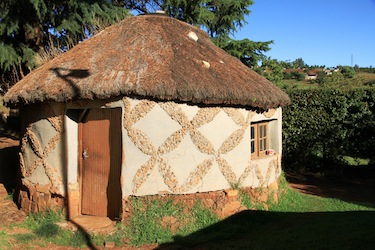Nunavut youth take an eye-opening trip to a southern African village
“Climate change is going to affect aboriginal people all over the world”

People in Phelisanong build their own houses using straw for roofs and mud for the walls. (PHOTO BY FRANK TESTER)

Jordan Konek of the Nanisiniq Arviat history project shares his photos with a boy from Phelisanong, Lesotho. (PHOTO BY FRANK TESTER)
FRANK TESTER
PHELISANONG, Lesotho — A world of difference lies between a global climate change conference in a modern coastal South African city and life in an impoverished, rural state.
That’s what Jordan Konek and Curtis Kuunaq of the Nanisiniq Arviat history project say since travelling to the state of Lesotho after the United Nations climate change conference in Durban wrapped up Dec. 9.
“Inuit are more caught up in technology and things that are modern,” Kuunaq said. “We have lots of store-bought food and modern transportation. These people [in Lesotho] are living like our elders used to live. People grow most of the food they eat. They don’t have modern transportation. Just like our elders used to do, they have to walk everywhere or use their animals to get around.”
The huge differences in how people live in the two southern African regions struck Kuunaq.
“In Durban people are caught up like us. In fact, they have stuff we don’t have. But what I learned is that there are big differences in the way people live here,” he said. “In Lesotho, people are living like some Inuit used to live. They have starvation, just like our ancestors. And they make their own huts, just like our elders used to make their own tents and igloos. There are [also] people who are very poor living in the cities.”
The contrast between mountainous Lesotho and cosmopolitan Durban couldn’t be greater, the two said during their visit to the Lesotho village of Phelisanong
Phelisanong is a special place built around a project. Founded in 2000 by a group of disabled and HIV positive villagers, people in Phelisanong now operate an HIV/AIDS outreach program, a regional food security program, a primary school, a high school, a community library, and a home for disabled and chronically ill children.
The warmth of the people in Phelisanong struck in Konek: despite suffering from poverty, illness and disabilities, the Bantu-speaking Basotho residents welcomed their Inuit guests with enthusiasm, eager to learn more about Inuit and the Arctic.
“Another thing people of Nunavut should know is that all people have emotions and feelings. People should not be discriminated against because they can’t shower or because they don’t have money. There are reasons for people being this way,” Konek said. “We don’t always have to try to look like Qablunaat or have the kind of public lives they have. We should all be accepted for who we are.”
Konek and Kuunaq said they learned so much from their visits to Durban, and then to Lesotho, that they haven’t had time to make sense of everything.
“But one thing we need to do is talk more to the world about Inuit culture. I met many people who had never heard of Inuit or even Eskimos,” Konek said.
However, indigenous people are going to have to work hard together to cope with climate change, he said.
“It’s obvious to me from visiting Lesotho that climate change is going to affect aboriginal people all over the world,” Konek said. We are all going to have to work together and get our governments to change how they are doing things, because it is just like it used to be. They are still not listening to us or to our elders.”
Konek and Kuunaq return to Arviat later this week.





(0) Comments